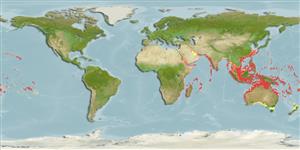Common names from other countries
>
Aulopiformes (Grinners) >
Synodontidae (Lizardfishes) > Synodontinae
Etymology: Synodus: Greek, syn, symphysis = grown together + Greek, odous = teeth (Ref. 45335).
More on author: Lacepède.
Environment: milieu / climate zone / depth range / distribution range
Ecologia
marinhas associadas(os) a recifes; intervalo de profundidade 0 - 121 m (Ref. 58302), usually 5 - 60 m (Ref. 37816). Tropical; 30°N - 45°S
Indo-Pacific: Red Sea and East Africa to the Hawaiian, Line, Marquesan, and Ducie islands, north to the Ryukyu Islands, south to the Lord Howe, Kermadec and Rapa islands (Ref. 1602). Reported from New Zealand (Ref. 5755) and Persian Gulf (Ref. 68964).
Comprimento de primeira maturação / Tamanho / Peso / Idade
Maturity: Lm 14.0 range ? - ? cm
Max length : 40.0 cm TL macho/indeterminado; (Ref. 637); common length : 30.0 cm TL macho/indeterminado; (Ref. 637)
Espinhos dorsais (total) : 0; Raios dorsais (total) : 10 - 14; Espinhos anais: 0; Raios anais : 8 - 10. Adults variable from grey to red (Ref. 48635). On some individuals, the hourglass- or saddle-shaped markings along its side may be obliterated by an almost solid dark red band (Ref. 1602). Large individuals are often thick-bodied, giving a hump-backed appearance (Ref. 1602).
Inhabits deep lagoon and seaward reefs to depths over 40 m (Ref. 9710); sometimes found on sandy bottoms concealing itself in the sand. Prefers to rest on hard surfaces and frequently occurs in pairs (Ref. 37816). Benthic (Ref. 58302). Feeds on small fishes by seizing these from passing schools, also shrimps (Ref. 89972). Caught with various types of artisanal gear; sold fresh or dried salted in markets. Minimum depth reported taken from Ref. 128797.
Ciclo de vida ou comportamento de acasalamento
Maturities | Reprodução | Spawnings | Egg(s) | Fecundities | Larvas
Randall, J.E., G.R. Allen and R.C. Steene, 1990. Fishes of the Great Barrier Reef and Coral Sea. University of Hawaii Press, Honolulu, Hawaii. 506 p. (Ref. 2334)
Status na Lista Vermelha da UICN (Ref. 130435)
CITES (Ref. 128078)
Not Evaluated
Ameaça para os humanos
Harmless
Uso pelos humanos
Pescarias: espécies comerciais
Ferramentas
Relatórios especiais
Baixar XML
Fontes da internet
Estimates based on models
Preferred temperature (Ref.
115969): 24.2 - 29, mean 27.8 (based on 2250 cells).
Índice de diversidade filogenética (Ref.
82804): PD
50 = 0.5000 [Uniqueness, from 0.5 = low to 2.0 = high].
Bayesian length-weight: a=0.00513 (0.00404 - 0.00652), b=3.19 (3.14 - 3.24), in cm Total Length, based on LWR estimates for this species (Ref.
93245).
Nível Trófico (Ref.
69278): 4.2 ±0.5 se; based on diet studies.
Resiliência (Ref.
120179): Elevada, tempo mínimo de duplicação da população menor que 15 meses (K=0.4).
Fishing Vulnerability (Ref.
59153): Low to moderate vulnerability (30 of 100).
